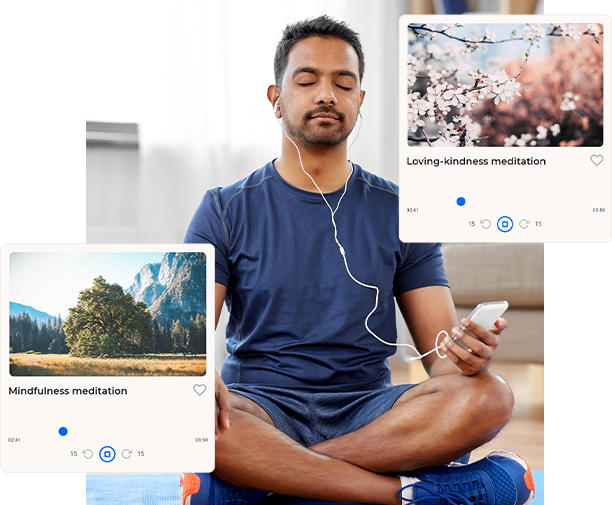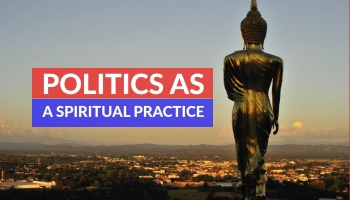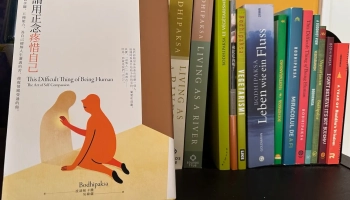
[ad_1]
As our lives become increasingly busy and demanding, it is essential to find a way to cultivate mental well-being and maintain our focus in the face of distractions. Meditation has long been recognized as a powerful tool to achieve these goals. By helping us develop a greater sense of inner peace, clarity, and self-awareness, meditation enables us to navigate life’s challenges more effectively. Better yet, learning how to meditate is easy.
In this article, we will explore the transformative potential of meditation and provide a step-by-step guide on how to practice it, so you can begin to experience its numerous health benefits for yourself. Regardless of your background, profession, or beliefs, meditation is a versatile practice that can be tailored to fit your individual needs and preferences.
Preparing for Your Meditation Journey

First, it’s time to consider the practical aspects of starting your practice. Establishing a solid foundation from the beginning will set the stage for a more fulfilling and rewarding meditation experience, and make it easier to learn how to meditate.
Choosing the Right Environment
One of the key elements to forming a successful meditation habit is finding a suitable environment that encourages stillness and focus. It’s essential to select a space that is relatively quiet, free from distractions, and comfortable. The ideal setting may vary depending on personal preferences, but it’s important to find a space where you can consistently practice meditation without interruption. This could be a dedicated room in your home, a quiet corner in your office, or even a peaceful outdoor space.
Developing a Regular Practice
Consistency is crucial when it comes to reaping the benefits of meditation. Just like physical exercise, meditation requires regular practice to strengthen the mental “muscles” responsible for focus, self-awareness, and emotional regulation. Set aside a specific time each day to meditate, ideally during a period when you are least likely to be disturbed or preoccupied with other tasks. Even just 10 to 20 minutes of daily practice can have a significant impact on your overall well-being.
Setting Intentions and Goals
Having a clear intention or goal for your meditation practice can help you stay motivated and focused on your progress. Your intention may be as simple as cultivating a greater sense of inner peace or as ambitious as developing a deeper understanding of your own consciousness. It’s essential, however, to approach your meditation exercise and goals with patience and self-compassion, recognizing that the path of meditation is a gradual process of self-discovery and growth. Embrace the journey, and allow your intentions to guide you without becoming overly attached to specific outcomes.
With the right environment, a consistent practice, and clear intentions, you will be well-equipped to embark on your meditation journey. In the following sections, we will discuss various meditation exercises and techniques and provide a step-by-step guide to help you begin your practice with confidence and ease.
Utilizing a Meditation App for Guidance
For those new to meditation or seeking guidance in refining their practice, using a meditation app can be an invaluable resource. A well-designed app, like Declutter The Mind, provides a structured approach to learning meditation techniques through expertly crafted courses and even guided meditation practices tailored for beginners. With clear instructions, helpful tips, and a variety of guided meditation styles to choose from, Declutter The Mind can help you establish a strong foundation for your practice and expedite your progress in achieving mental clarity and inner peace. By incorporating a meditation app into your daily routine, you can effortlessly access expert guided meditations and support, making it easier than ever to embark on your meditation journey and experience its transformative benefits.
400+ Free Guided Meditation PracticesDeclutter The Mind will help you live more mindfully and understand your mind better with a growing library of free guided meditation practices, courses, and daily meditation practices.
Core Meditation Techniques

As you embark on your journey to learn how to meditate, it’s essential to familiarize yourself with the core techniques that form the foundation of most meditation practices. While there are countless meditation styles and variations, the following techniques are widely recognized for their effectiveness in cultivating focus, self-awareness, and emotional well-being. When deciding what kind of meditation to start with, there’s plenty of options.
Mindfulness Meditation
Mindfulness meditation is a practice that through meditation helps encourages non-judgmental awareness of the present moment. By cultivating a curious, open, and accepting attitude towards your thoughts, emotions, and bodily sensations, you can develop greater self-awareness and emotional resilience. A basic mindfulness meditation practice can be done seated or as a walking meditation practice.
Breath Awareness
Breath awareness or breath meditation is a fundamental aspect of mindfulness meditation. By focusing your attention on the natural flow of your breath, you can anchor your mind in the present moment and create a foundation for cultivating deeper awareness. The breath serves as a constant, reliable point of focus that can be accessed at any time, making it an ideal tool for beginners and experienced meditators alike.
Body Scanning
Another essential component of mindfulness meditation is the practice of body scan meditation. This technique involves systematically directing your attention to different parts of your body, observing any sensations, tension, or discomfort that may appear in the present moment. By cultivating a greater awareness of your physical experience, through body scan, you can develop a more intimate connection with your body and learn to respond more skillfully to stress and discomfort.
Concentration Meditation
Concentration meditation is a practice designed to enhance your ability to maintain focused attention on a single object or point of reference in the present moment. This could be your breath, a mantra, a visualization, or any other object that resonates with you. By training your mind to remain focused on this object, you can develop greater mental clarity, stability, and concentration.
Loving-Kindness Meditation (Metta)
Loving-kindness meditation, or Metta, is a practice that fosters the cultivation of compassion, empathy, and goodwill towards oneself and others. Through a series of guided visualizations guided meditations, and affirmations, you can learn to generate positive emotions and extend them towards yourself, loved ones, acquaintances, and even those with whom you have difficulty. This practice can help you develop greater emotional intelligence, improve your relationships, and enhance your overall sense of well-being. This practice can be done seated or as a walking meditation.
By exploring these core techniques and discovering which resonate most with you, you can begin to develop a personalized meditation practice that aligns with your unique needs and goals. In the following section, we will provide a step-by-step guide to help you get started with your practice and begin to experience the transformative benefits of meditation.
A Step-by-Step Guide to Meditation

With an understanding of the core techniques and some basic mindfulness meditation as the foundation for your practice in place, it’s time to begin your meditation journey. By learning how to meditate, the following step-by-step guide will provide you with a simple yet effective framework for starting your practice and experiencing the benefits of meditation firsthand.
Finding a Comfortable Posture
Begin by choosing a comfortable posture that allows you to remain alert and relaxed throughout your meditation session. You may sit on a cushion, a chair, or even lie down if that feels most comfortable for you. Ensure that your spine is straight but not rigid, allowing for natural breathing and maintaining a sense of ease.
Beginning with Breath Awareness
Once you have settled into your chosen posture, gently close your eyes and bring your attention to your breath. Without trying to control or alter your breathing, simply observe the natural rhythm of your inhales and exhales. Notice the sensation of the air entering and leaving your nostrils, or the rise and fall of deep breath in your chest and abdomen.
Cultivating a Non-Judgmental Attitude
As you focus on your breath, it’s essential to cultivate a non-judgmental attitude towards your thoughts, emotions, and bodily sensations. When you notice your mind wandering, gently acknowledge the distraction without judgment or frustration, and redirect your attention back to your breath. This process of recognizing and releasing distractions is a fundamental aspect of meditation that helps to develop greater self-awareness and mental stability.
Recognizing and Releasing Distractions
Throughout your meditation session, you will inevitably encounter distractions in the form of thoughts, emotions, or sensations. Instead of becoming frustrated or lost in these distractions, use them as opportunities to practice mindfulness and self-compassion. Gently acknowledge the distraction, release it, and return your focus to your breath or chosen meditation object.
Returning Focus to the Breath or Chosen Meditation Object
As you release distractions and return your focus to your breath or meditation object, you are strengthening your ability to maintain concentration and cultivating greater mental clarity. Remember that this process of returning your focus is an integral part of meditation, and each time you do so, you are building your mental resilience and awareness.
Concluding the Meditation Session
After your chosen duration of practice, gradually bring your awareness back to your physical surroundings, becoming more aware of the sensations in your body and the sounds around you. Gently open your eyes and take a moment to reflect on your experience, acknowledging any insights or shifts in perspective that may have occurred during your meditation.
By following this step-by-step guide, you will be well on your way to experiencing the transformative benefits of meditation and cultivating greater inner peace, clarity, and self-awareness. Remember that patience and persistence are key, and with regular practice, you will begin to notice profound changes in your own mental health, and emotional well-being.

As you delve deeper into your meditation practice, you may encounter various challenges that can test your resolve and commitment. By recognizing these hurdles and developing strategies to overcome them, you can strengthen your practice, reduce stress, and continue to reap the benefits of meditation.
Dealing with Restlessness and Impatience
One common challenge meditators face is restlessness or impatience during their practice. Your mind may feel constantly active or agitated, making it difficult to maintain focus on your breath or meditation object. In these moments, it’s important to remind yourself that restlessness is a natural part of the process and that, with practice, it will subside. Cultivate patience and self-compassion, and gently redirect your attention back to your point of focus whenever restlessness arises. This is where guided meditation with an app like Declutter The Mind can keep your mind focus and deal with restlessness. A walking meditation practice can also help with restlessness and impatience.
Managing Intrusive Thoughts and Emotions
Another challenge many meditators face is the tendency for intrusive thoughts and emotions to emerge during meditation. Rather than trying to suppress or ignore these thoughts, use them as opportunities to practice mindfulness and non-judgmental awareness. Gently acknowledge the thought or emotion, observe it without getting caught up in its content, and then release it, returning your focus to your breath or meditation object.
Maintaining Consistency in Practice
Developing a consistent meditation practice is essential for experiencing its full benefits, yet many individuals struggle to maintain regularity in their practice. To help establish consistency and a meditation habit, try setting a specific time and place for your meditation sessions, and consider using a meditation app like Declutter The Mind to keep you accountable and motivated. It’s also helpful to remind yourself of your intentions and goals for regular meditation practice, as this can provide an ongoing source of motivation and purpose.
By addressing these common challenges head-on and developing strategies to overcome them, you will be better equipped to maintain a consistent and effective meditation practice. Embrace the journey, knowing that each challenge you face is an opportunity for growth and self-discovery.
Integrating Meditation into Daily Life

As you progress in your meditation journey, you may begin to notice the transformative effects of your practice extending beyond your meditation sessions and into your daily life. By intentionally integrating mindfulness and meditation principles into your everyday experiences, you can cultivate a more balanced, present, and fulfilling existence.
Mindful Moments in Everyday Activities
One way to integrate meditation into your daily life is by bringing mindful awareness to everyday activities such as eating, walking (with a walking meditation), or even washing dishes. By fully engaging in these tasks with a non-judgmental, present-moment awareness, you can transform ordinary experiences into opportunities for mindfulness and deepened self-awareness.
Responding to Stress and Difficult Emotions
Meditation can also be a valuable tool for managing stress and difficult emotions in daily life. When you encounter a challenging situation or experience strong emotions, try pausing and taking a few deep breaths, bringing your awareness to the present moment. This simple act can help create space between your emotions and your reactions, allowing you to respond with greater clarity and wisdom.
Enhancing Relationships through Mindful Communication
Integrating this mindfulness practice into your communication with others can lead to more meaningful and fulfilling relationships. By cultivating active listening, being present, and responding with empathy and understanding, you can strengthen connections and foster a deeper sense of connection with those around you.
Cultivating Gratitude and Appreciation
Another way to integrate meditation principles into daily life is by cultivating an attitude of gratitude and appreciation. Regularly reflecting on the positive aspects of your life, expressing gratitude for the people and experiences that bring you joy, and acknowledging the beauty in ordinary moments can help to create a more resilient and positive outlook on life.
By intentionally incorporating these types of meditation and mindfulness into your daily life, you can deepen your practice and experience the benefits of greater presence, balance, and fulfillment. Remember that meditation is not just a practice reserved for the cushion or chair, but a way of being that can permeate every aspect of your existence.
The Ongoing Journey of Meditation

As you continue to explore the world of meditation, it’s important to remember that the practice is an ongoing journey of self-discovery, growth, and transformation. Rather than viewing meditation as a destination to be reached or a goal to be achieved, embrace the process as an ever-evolving path toward greater self-awareness, inner peace, and personal growth.
Embracing the Nonlinear Nature of Progress
Progress in meditation can often be nonlinear, with periods of rapid growth followed by plateaus or even setbacks. It’s essential to approach your practice with patience, compassion, and an open mind, recognizing that each experience, whether pleasant or challenging, offers valuable insights and opportunities for growth.
Continuing to Refine Your Practice
As learning how to meditate deepens, you may find yourself drawn to explore new techniques, attend retreats, or engage with a meditation community. Stay open to these opportunities, and be willing to adapt and refine your practice as you uncover new insights and develop a deeper understanding of yourself and the world around you.
Sharing the Benefits with Others
One of the most rewarding aspects of meditation is the ability to share its transformative benefits with others. As you continue to grow in your practice, consider sharing your experiences, insights, and wisdom with friends, family, or even your community. By offering support and guidance to those interested in meditation, you not only deepen your own understanding but also contribute to the collective well-being of those around you.
By approaching your meditation journey with curiosity, patience, and an open heart, you can continue to deepen your practice and experience the profound benefits of a more mindful, present, and fulfilling life. Embrace the path, and let it guide you toward greater self-awareness, resilience, and personal growth.
Conclusion

Learning how to meditate is a transformative practice with the potential to profoundly impact not only our personal well-being but also the well-being of our society and the world at large. By committing to a consistent meditation practice and integrating mindfulness and compassion into our daily lives, we can experience greater inner peace, self-awareness, and resilience, and contribute to the cultivation of a more harmonious, empathetic, and conscious world.
The journey of meditation is an ongoing process of growth and self-discovery, one that invites us to continually refine our practice, share our experiences, and remain open to new insights and opportunities. By embracing this journey with curiosity, patience, and an open heart, we can unlock our full potential and contribute to the collective well-being of our communities and our planet.
In the words of the great poet Rumi, “Your task is not to seek for love, but merely to seek and find all the barriers within yourself that you have built against it.” Meditation can serve as a powerful tool for dismantling these barriers and revealing the innate wisdom, compassion, and interconnectedness that lie at the heart of our shared human experience.
[ad_2]
Source link







